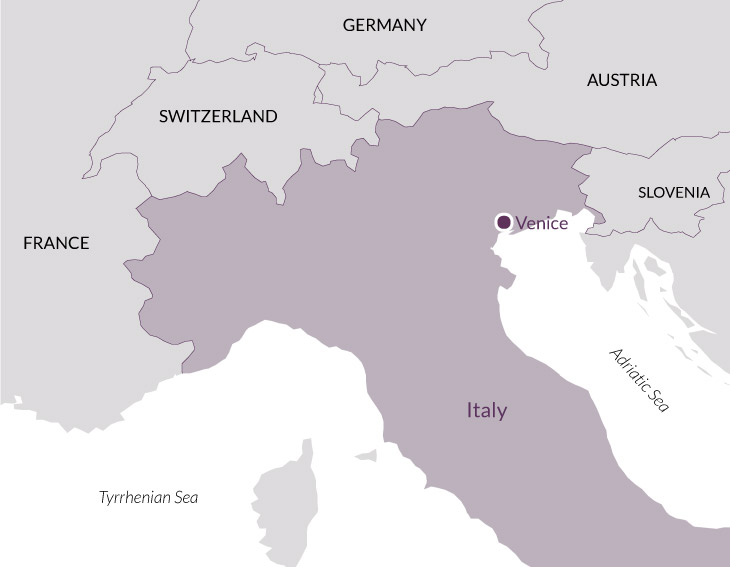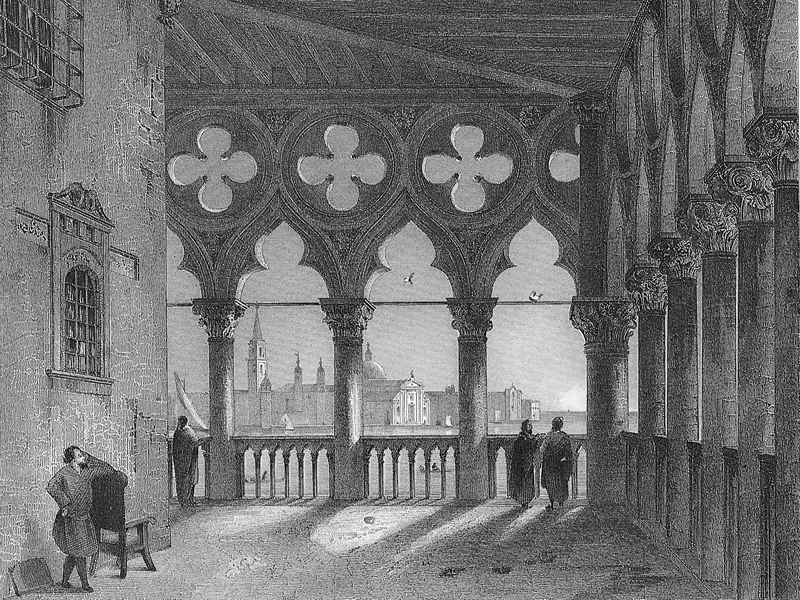Overview
Just as Venice possesses but a single piazza among dozens of campi, it has only one building correctly called a ‘palazzo’. The singularity is important: the Doge’s Palace (Palazzo Ducale), like the Piazza San Marco, was the locus of La Serenissima’s public identity and seat of her republican government. Unlike her rivals in Florence and Milan she had no ruling dynasties to dictate polity, by contrast developing a deep aversion to individual aggrandizement and over-concentrated power. While the person and palazzo of the Doge embodied their municipal identity, it was in their private houses that Venice’s mercantile oligarchs expressed their own family wealth and status.
These case (in Venetian parlance ca’) were built throughout the city. In the absence of primogeniture, many branches sprung from the two hundred-odd noble families, leading to several edifices of the same name – an obstacle for would-be visitors.
These houses were unlike any other domestic buildings elsewhere in the world: erected over wooden piles driven into the mud flats of the lagoon, they remained remarkably uniform over the centuries in their basic design, combining the functions of mercantile emporium (ground level) and magnificent residence (upper floors).
They were however built in a fantastic variety of styles: Veneto-Byzantine, Gothic, Renaissance, Baroque and Rococo. Sometimes there is a touch of Islamic decoration. As new families bought their way into the aristocracy during the long period of the Republic’s economic and political decline, they had their residences refurbished in Rococo splendour by master artists such as Giambattista Tiepolo. Many of these palaces have survived the virtual extinction of the Venetian aristocracy and retain their original, if faded, glory.
Palaces for nobles will be considered in conjunction with those for the non-noble cittadino (wealthy merchant) class and the housing projects for ordinary Venetian popolani, which rise cheek by jowl in the dense urban fabric.
Some of the places visited are familiar and readily accessible to the public. Others are opened only by special arrangement with the owners, whether a charitable organisation, branch of local government or descendants of the original occupants. Some of these cannot be confirmed until nearer the time.
A private, after-hours visit to the Basilica di San Marco, the mosaic interior illuminated for your benefit, is a highlight of this tour. As is an opportunity to see up close ‘the most beautiful street in the world’, the Grand Canal, from that most Venetian of vantage-points, a gondola.
Day 1
Fly at c. 1.00pm (British Airways) from London Heathrow to Venice. Cross the lagoon by motoscafo (water-taxi) and travel up the Grand Canal to the doors of the hotel. Luggage is transported separately by porters. Dinner this evening is in the privately owned 16th-century Palazzo Corner Gheltoff Alverà (by special arrangement).
Day 2
2024: see the palazzi on the Grand Canal from the viewpoint of a gondola. The former Casino Venier is a uniquely Venetian establishment that was part private members’ bar, part literary salon, part brothel (by special arrangement). Designed by Longhena (c. 1667) and Giorgio Massari (c. 1751), the Ca’ Rezzonico is perhaps the most magnificent of Grand Canal palaces, and contains frescoes by Tiepolo; it is now a museum of 18th-century art. Visit Palazzo Pisani, one of the largest patrician palaces in Venice and now the music Conservatory.
2025: see the palazzi on the Grand Canal from the viewpoint of a gondola. The former Casino Venier is a uniquely Venetian establishment that was part private members’ bar, part literary salon, part brothel (by special arrangement). Designed by Longhena (c. 1667) and Giorgio Massari (c. 1751), the Ca’ Rezzonico is perhaps the most magnificent of Grand Canal palaces, and contains frescoes by Tiepolo; it is now a museum of 18th-century art.
Day 3
Visit the Palazzo Ducale, supremely beautiful with its 14th-century pink and white revetment, late Renaissance gilded halls and paintings by Tintoretto and Veronese. The Palazzo Grimani at Santa Maria Formosa became in the mid-16th century the purpose-built site of the family collection of antiquities, which were then bequeathed to the Venetian Republic. After-hours visit to the Basilica di San Marco where the mosaic-encrusted interior is illuminated exclusively for your benefit.
Day 4
With its elegant tracery and abundant ornamentation, the Ca’ d’Oro, also on the Grand Canal, is the most gorgeous of Venetian Gothic palaces; it now houses the Galleria Franchetti. The 13th-century Fondaco dei Turchi is a unique survival from the era; today it is the natural history museum so focus is on the façade.
Day 5
Visit the privately owned 17th-century Palazzo Albrizzi which has some of the finest stucco decoration in Venice (by special arrangement). Travel by motoscafo to Venice airport. Fly to London Heathrow, arriving at c. 7.15pm.
The tour is dependent on the kindness of many individuals and organisations, some of whom are reluctant to make arrangements far in advance, so the order of visits outlined above may change and there may be substitutions for some palaces mentioned.

Dr Michael Douglas-Scott
Dr Michael Douglas-Scott mixes scholarship with accessible discourse, with reasoned opinion, and is highly sought-after as an art history lecturer. He has lectured for New York University (London campus) and Birkbeck College, University of London, specialising primarily in 16th-century Italian art and architecture. He studied at the Courtauld and Birkbeck College and lived in Rome for several years. He has written articles for Arte Veneta, Burlington Magazine and the Journal of the Warburg & Courtauld Institutes.
Price, per person
In 2024: Two sharing: £3,010 or £2,830 without flights. Single occupancy: £3,430 or £3,250 without flights.
In 2025: Two sharing: £3,230 or £3,030 without flights. Single occupancy: £3,690 or £3,490 without flights.
Included
Flights (Euro Traveller) with British Airways (Airbus 320); a vaporetto (water-bus) pass; travel between the hotel and Venice Airport by water-taxi; luggage porterage between the hotel and Venice airport; hotel accommodation as described below; breakfasts; 3 dinners with wine, water, coffee; all admissions; all tips; all taxes; the services of the lecturer, tour manager and local guide.
Accommodation
Hotel Palazzo Sant’Angelo, Venice: 4-star hotel in an excellent location on the Grand Canal near Campo Sant’Angelo and the Rialto Bridge. Single rooms are doubles for sole use.
How strenuous?
The nature of Venice means that the city is more often than not traversed on foot. Although part of her charm, there is a lot of walking along the flat and up and down bridges; standing around in museums and palaces is also unavoidable. The tour should not be attempted by anyone who has difficulty with everyday walking and stair-climbing. Fitness is essential.
Are you fit enough to join the tour?
Group size
Between 8 and 18 participants.
Travel advice
Before booking, please refer to the FCDO website to ensure you are happy with the travel advice for the destination(s) you are visiting.
Combine with
In March 2024:
The Art of Florence, 18–24 March
Opera In Vienna, 2–7 April
Civilisations of Sicily, 2–14 April
Gardens of the Riviera, 5–11 April
In November 2024:
Istanbul Revealed, 24–31 October
Sicily: from the Greeks to the Baroque, 25 October–3 November
Gastronomic Catalonia, 28 October–4 November
Florentine Palaces, 30 October–3 November
Art in Madrid, 30 October–3 November
Opera at Wexford, 30 October–3 November
Venice Revisited, 11–16 November
In March 2025:
Florence & Venice, 3–10 March
Indian Summer, 18–29 March
In November 2025:
Palladian Villas, 28 October–2 November

'A really interesting selection of palazzi…Some very special features (such as the private out-of-hours tour of San Marco and the visits to privately owned palazzi) on which it is hard to put a price.'
'After an initial look in the lengthy domed entrance area of St Mark's Basilica, we were asked to sit in the nave. The lights were extinguished and after a minute or so, began to gradually come on, one by one, first quite faint and then slowly increasing in intensity until we were all totally swathed in gold.'
'The itinerary was splendid and access to otherwise closed venues were an added plus.'
'This was our first trip and will not be our last.'
'The three private palazzos we visited were fascinating, and the hosts were interesting people in their own right who talked fascinatingly about their homes and histories.'
'The content of our tour was priceless, especially the visits to private palazzos and the private tour of St Marks, which was unforgettable.'
